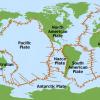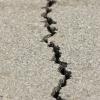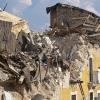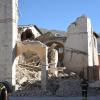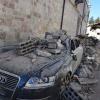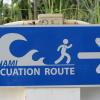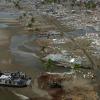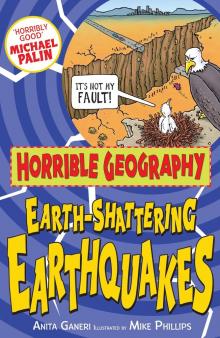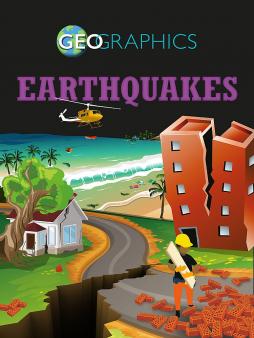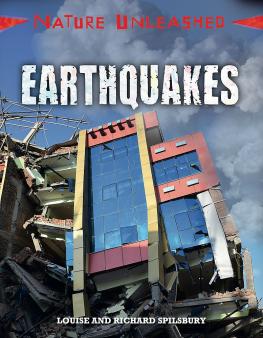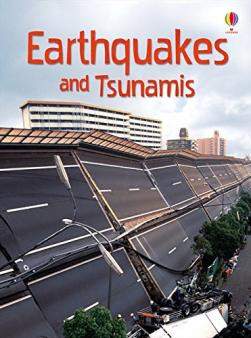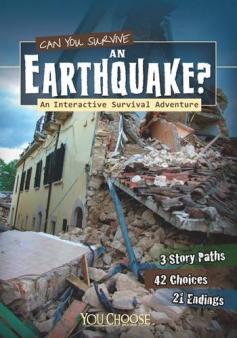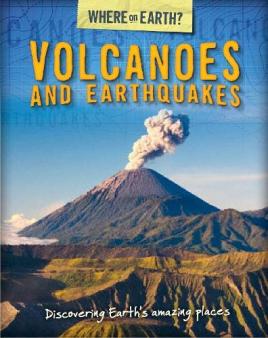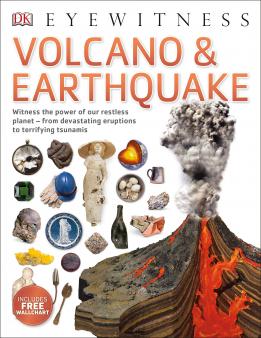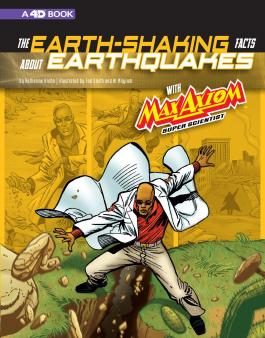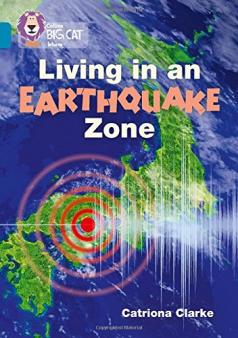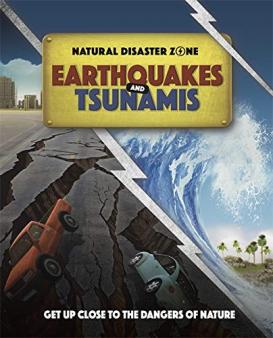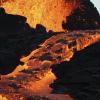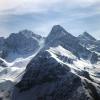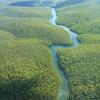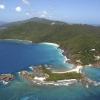Earthquakes
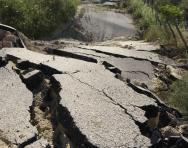
Although the ground we walk on seems completely solid, the Earth is actually made up of huge pieces of flat rock called tectonic plates. These move very, very slowly, and places where they meet are called faults.
When these plates rub together, the movement forces waves of energy to come to the earth's surface. We feel this on the Earth’s surface as an earthquake. Earthquakes can sometimes be nothing more than small tremors or shakes, but sometimes they can cause damage and devastation.
Earthquakes can make buildings fall down and set off landslides, as well as having many other deadly effects. An earthquake that occurs at the bottom of the sea can push water upwards and create massive waves called tsunamis.
Top 10 facts
- Earthquakes involve the powerful movement of rocks in the Earth’s crust. The rapid release of energy creates seismic waves that travel through the earth.
- Almost 80% of all the planet's earthquakes occur along the rim of the Pacific Ocean, called the "Ring of Fire"; a region that encircles the Pacific Ocean and is home to 452 volcanoes (over 75 percent of the world's active and dormant volcanoes).
- Seismometers are used to measure the magnitude of earthquakes. You are unlikely to feel a magnitude 3 earthquake but magnitude 6 earthquakes could potentially cause large damage.
- A Richter Scale is a device that gauges the magnitude (the energy it generates) of the earthquake. It was originated by American geophysicist Charles Francis Richter.
- The largest recorded earthquake in the world was a magnitude 9.5 in Chile on May 22, 1960. More recently, an earthquake that hit the Tohoku region of Japan on March 11, 2011, had a magnitude of 9.0 and killed over 15,000 people.
- Alaska is the most earthquake-prone state in the world.
- It is important for earthquake-prone countries such as Japan to build houses and buildings that react well to earthquakes. Good engineering can help stop buildings collapsing under the stress of large earthquakes, for example by building structures which can ‘wobble’ when an earthquake hits.
- In Ancient Greece, people believed that the god of the sea, Poseidon, caused earthquakes. When he was angry, Poseidon would strike the ground with his trident and set off an earthquake. His unpredictable, violent behaviour earned him the nickname ‘Earth-Shaker’.
- Tectonic plates move less than 3 inches (17 cm) per year. However, a tectonic plate movement of just 20 cm is enough to set off a major earthquake.
- Scientists think that animals may sense weak tremors before a quake. Other scientists think that animals may sense electrical signals set off by the shifting of underground rocks.

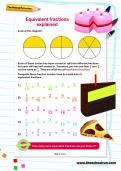
Boost Your Child's Maths & English Skills!
- Start your child on a tailored learning programme
- Weekly resources delivered to your dashboard
- Keep your child's learning on track
Did you know?
- The epicentre of an earthquake is the area on the surface, above the point where the earthquake originated. The speeds of the seismic waves enable scientists to locate the epicentre of an earthquake.
- The hypocentre of an earthquake is the area below the earth’s surface; it is the place where the earthquake began.
- Over 70% of earthquakes occur around the edge of the Pacific Ocean. The worst affected areas include; Japan, China, the Philippines, Indonesia, Australasia and the West coast of North and South America.
- A tsunami is a sequence of huge waves of water that usually occur in oceans or large lakes. Tsunamis are caused by disturbances within the surrounding areas; they are usually caused by underwater earthquakes, volcanic eruptions and landslides. A tsunami is not a tidal wave – these are caused by the forces of the moon, sun, and planets upon the tides, as well as the wind as it moves over the water.
- Earthquakes can destroy communities, injure people and lead to deaths. Often earthquakes are only the beginning of the damage that can occur. The effects of an earthquake can be any or all of the following: buildings damaged and made unstable, burst water pipes that could result in water pollution, contamination and flooding; burst gas pipes potentially leading to explosions or fires; businesses, industries, homes and public buildings destroyed; transport links and emergency services disrupted. Other risks involve consequences to the landscape, environment and wildlife along with the risk of landslides and tsunamis.
- There are about 500,000 earthquakes a year around the world, as detected by sensitive instruments. About 100,000 of those can be felt, and only 100 or so cause damage each year. Each year, the southern California area alone experiences about 10,000 earthquakes, most of them not felt by people.
- Oil extraction can cause minor earthquakes. Because oil generally is found in soft and squishy sediment, when oil is removed other rock moves in to fill the space left behind, creating mini earthquakes that are not noticeable to humans.
Earthquake gallery:
- The Ring of Fire, an area in the Pacific Ocean where lots of earthquakes and volcanic eruptions occur
- Earthquakes can open up holes in roads
- Earthquake damage in Italy
- A tsunami evacuation route
- The devastation following a tsunami
Gallery
About
An earthquake is what happens when two blocks, or ‘plates’ of the Earth suddenly slip past one another. The surface where they slip is called the fault or fault plane. The location below the earth’s surface where the earthquake starts is called the hypocentre, and the location directly above it on the surface of the earth is called the epicentre.
The earth has four major layers: the inner core, outer core, mantle and crust. The crust and the top of the mantle make up a thin layer on the surface of our planet. But this layer is not all in one piece – it is made up of many pieces like a jigsaw puzzle covering the surface of the Earth. These puzzle pieces keep slowly moving, sliding past one another and occasionally bumping into each other. We call these puzzle pieces tectonic plates, and the edges of the plates are called the plate boundaries. The plate boundaries are made up of many faults, and most of the earthquakes around the world occur on these faults. Since the edges of the plates are rough, they get stuck while the rest of the plate keeps moving. Finally, when the plate has moved far enough, the edges unstick on one of the faults and there is an earthquake.
While the edges of faults are stuck together, and the rest of the plate keeps moving, the energy that would normally cause the blocks to slide past one another is being stored up. When the moving block suddenly ‘unsticks’, all that stored up energy is released. The energy radiates outward from the fault in all directions in the form of seismic waves like ripples on a pond. The seismic waves shake the earth as they move through it, and when the waves reach the earth’s surface, they shake the ground and anything on it.
Instruments called seismographs are used to determine how large the earthquake was. The instrument uses a weighted pen and a spring and the vibrations from the earthquake makes the pen draw lines onto some paper. A short wiggly line that doesn’t wiggle very much means a small earthquake, and a long wiggly line that wiggles a lot means a large earthquake. The length of the wiggle depends on the size of the fault, and the size of the wiggle depends on the amount of slip.
The size of the earthquake is called its magnitude. There is one magnitude for each earthquake. Scientists also talk about the intensity of shaking from an earthquake, and this varies depending on where you are during the earthquake.
Words to know for earthquakes:
consequences - the results of a previous action
dormant - in an inactive state, when growth and development slow or stop
energy - a supply or source of electrical, mechanical, or other form of power
epicentre - the exact location on the Earth's surface directly above the focus of an earthquake
extraction - to pull something out, often using force
faults - a displacement of rock layers in the Earth's crust in response to stress
hypocentre - the point within the earth where an earthquake originates
magnitude - a measure of the energy of an earthquake, specified on the Richter scale
radiates - to send out energy such as heat or light, in the form of rays or waves, or be sent out in this form
sediment - material eroded from pre-existing rocks that is transported by water, wind, or ice and deposited elsewhere
seismic - relating to or caused by an earthquake or earth tremor
seismograph - an instrument that detects the presence of an earthquake and measures and records its magnitude
tectonic - relating to the forces that produce movement and deformation of the Earth's crust
tremors - a quivering or vibration caused by slippage of the Earth's crust at a fault, especially before or after a major earthquake
trident - an instrument, spear, or weapon with three prongs
tsunami - a long, high sea wave caused by an earthquake or other disturbance
Related Videos
Just for fun...
- A selection of earthquake activities and simulations
- A disaster simulation game for older children
- Download and complete some earthquake activity worksheets
- Try the Disaster Master game
- Use a slinky to simulate earthquake waves
- Gather a disaster emergency kit in an online learning game
- Can you build your own 3D model of an earthquake with Lego and playdough?
- Understand the principle of earthquakes by making a paper model of how earthquakes happen
Best books about earthquakes for children
Find out more about earthquakes
- Watch a BBC Bitesize introductory video about earthquakes
- Earthquakes in our times: Newsround information
- An illustrated guide to earthquakes and tsunamis and why they happen
- An animated guide to how earthquakes happen
- The Geological Society has a complete guide to earthquakes, with fact sheets, interactive resources, videos and case studies
- Some experiments to try to learn more about earthquake science and preparedness
- Plate tectonics explained for children
- Find out more about plate tectonics with your very own Plate Tectonics Passport
- Watch an earthquakes educational film
- Use an online simulator for events on the San Andreas Fault in California to explore the amount of energy released by an earthquake
- Find out how animal behaviour could help us predict earthquakes!
- Illustrated guide to earthquakes from DKfindout!
- Look at some earthquake maps and diagrams
See for yourself
- What is an earthquake?
- Could you become an earthquake scientist one day?
- See current seismic activity on a world map
Also see

Give your child a headstart
- FREE articles & expert information
- FREE resources & activities
- FREE homework help
